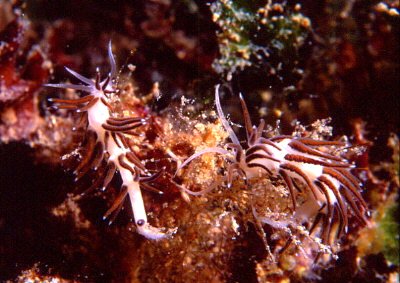
Piseinotecus gabinierei
(Vicente, 1975)
Order: NUDIBRANCHIA
Suborder: AEOLIDINA
Family: Glaucidae
PHOTO
Croatia, Rab, divesite "Supetaska Draga", size 3 cm, depth 32 m, August 16, 2000. Photo: Franco de Lorenzi.
The whole body is translucent white with a dusting of opaque white towards the tips of the oral tentacles and rhinophores. The body appears white from the colour of the viscera, and the ceratal digestive gland ducts range from dark brown to almost black. The anterior foot corners are extended into short angular tentacles, and the oral tentacles are almost as long as the tapering rhinophores which bear traces of annulations, or wrinkles, even when fully extended. The cerata are arranged in 7 groups along each side. The cerata in the anterior three groups have a common stalk which may divide into 2 branches. It grows to approx 30mm in length.
See message below.
Reference:
• Vicente, N. (1975) Un nouveau espece de gasteropode nudibranche en Mediterranee Facelina gabinierei n.sp. Trav. Sci. Parc. Nat. Port. Cros., 1: 67-74.
Rudman, W.B., 2003 (March 19) Piseinotecus gabinierei (Vicente, 1975) . [In] Sea Slug Forum. Australian Museum, Sydney. Available from http://www.seaslugforum.net/find/pisegabi
Related messages
Piseinotecus gabinierei - egg ribbon?
November 7, 2008
From: Miquel Pontes
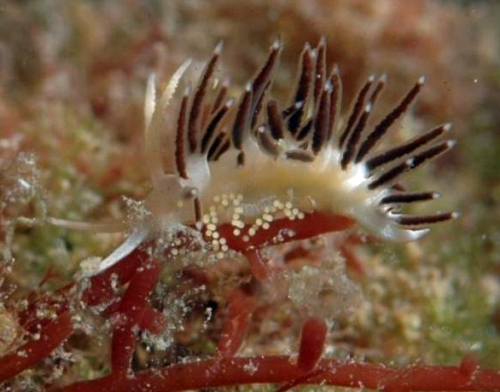
Concerning message #20009:
Dear Bill,
in our last dive we came across Piseinotecus gabinierei, in this case we found it at 15 meters of water, over the remains of the Llanishen shipwreck in Cala Caials, Cadaqués (Spain).
Apparently this is a very rare nudibranch in our coast, so our observation was used by Dr. Manuel Ballesteros (University of Barcelona) to publish a paper where this was rated as the first finding of this nudibranch in the North East coast of Spain.
Locality: Cala Caials, Cadaqués, Girona, 15 metres, Spain, Mediterranean Sea, 25 october 2008, Shipwreck covered with algae over rocky bottom. Length: 15 mm.. Photographer: Miquel Pontes.
The animal we found this time was about 15 mm long and was resting on an algae branch (Sphaerococcus coronopifolius ).
It was interesting to view the slightly ringed rhinophores (as discussed in my previous post for this nudibranch) but also of an egg ribbon which we could not make it clear if it was belonging to this species, or if the animal was feeding on it, as it is supposed that P.gabinierei feeds upon hydrarians.
I wanted to share this picture with you and the forum participants to discuss the subject.
Best regards,
Miquel Pontes.
miquelpontes@gmail.com
Pontes, M., 2008 (Nov 7) Piseinotecus gabinierei - egg ribbon?. [Message in] Sea Slug Forum. Australian Museum, Sydney. Available from http://www.seaslugforum.net/find/22012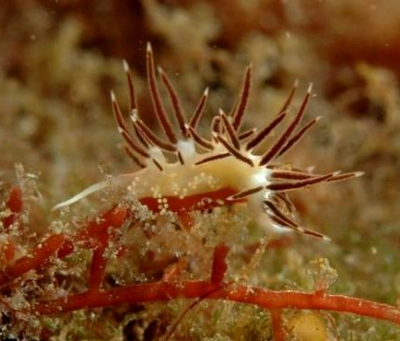
Thanks Miquel,
Hopefully someone will be able to comment on the egg ribbon of this species. Concerning its food, Vicente in his original description mentions that the nematocysts in its cnidosacs were from the hydroid Eudendrium, so I think we can be sure that its presence on the algae is through convenience rather than necessity.
Best wishes,
Bill Rudman
Piseinotecus gabinieri - anatomical features
May 2, 2008
From: Dominique Horst

Concerning message #20009:
Hello Bill,
For the second time I have found Piseinotecus gabinieri.
On the first photo, a double hole can be seen on the upper part of the mantle. Is this the reproductive duct?
In the lower photo, I've noticed yellow and one dark purple spots.
Not sure if these spot are something visible by transparency or coloured spots on the mantle? They are not visible on the other side. Are these spots in N.Vicente's description ? On M. Pontes photo, yellow spots are also visible...
Locality: Villefranche sur mer, 5 m, France, Mediterranean sea, 27 April 2008. Length: 20 mm. Photographer: Dominique Horst.
Kind regards,
Dom.
http://www.bathymed.net/crbst_274.html
dominique.horst@wanadoo.fr

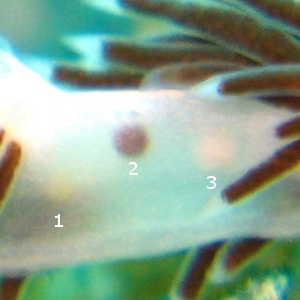
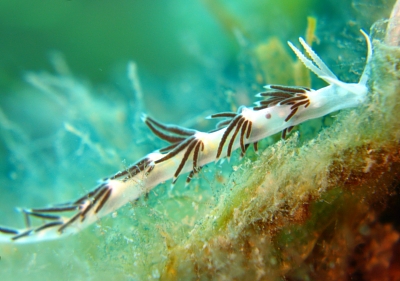
Dear Dom.,
Thanks for these photos which show us some interesting anatomical features. Sea Slugs have evolved from snails in which all the body openings - kidney, anus, reproductive - opened above the head (because their shell only had one opening). I briefly discuss on the Detorsion page how with the gradual loss of the shell, slugs began to untwist until we reach groups like the dorids in which the anus is back in the posterior midline like most other animals. However during this clockwise untwisting, not all groups untwisted as much as others and so these openings can be found at various places down the right side of the body. In the aeolids, all the openings, including the anus, stopped somewhere in the upper half of the right side. In your upper photo, the left (and larger) of the two opening is the anus, and the smaller one alongside is the kidney. The common genital opening can't be seen, but it will be a little bit further forward under the anterior clump of cerata. In your lower photo there is a whitish mass just in front and below the first cerata which could be the genital opening. I couldn't see any detail in the large file you sent me so I have not included a close-up.
Now for the spots. Vicente did not mention them in his description. Perhaps they were not visible in his specimens. They are not pigment on the skin but are internal structures.
[1] The yellow spots are part of the reproductive system. They are lobules of the ovotestis, and each produces eggs and sperm. In mature aeolids, variously coloured 'balls' like this are often visible through the body wall.
[2] The brown or purple spot is, I suspect, a bolus of waste from the digestive gland making its way down the intestine to the anus. If you look carefully you can just make out the anus and kidney as dull dark spots just above the brown ball.
[3] The pinkish spot is part of the reproductive system. I am not sure which part, but the glands that make the capsule around each egg, the egg case, and and prostatic fluid, and sacs that store the sperm, are all together in a mass near the genital opening.
Hope that all makes sense. Thanks also for the url to your growing website. It is good to get such nice groups of photos of your wonderful fauna.
Best wishes,
Bill Rudman
Re: Piseinotecus gabinieri - rings on rhinophores
May 2, 2008
From: Dominique Horst
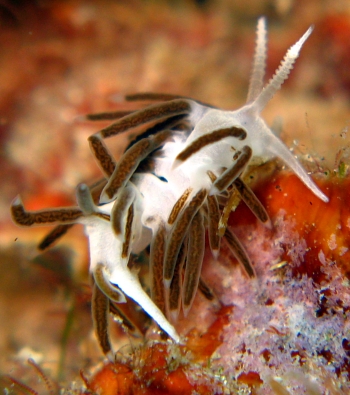
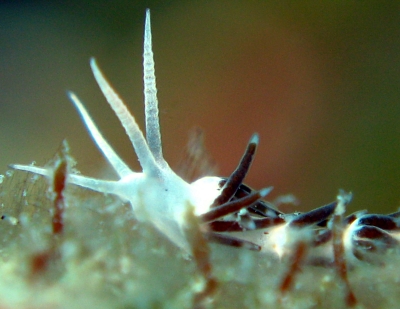
Concerning message #20009:
Hi Bill,
We found today two individuals, both at the same place. They showed different states of rings. May be this is related to different development steps? The second [lower photos] could be more juvenile?
Locality: Antibes, 8 m, France, Mediterranean Sea, 30 March 2008. Length: 15 mm. Photographer: Dominique Horst.
Kind regards,
Dominique
dominique.horst@wanadoo.fr
Horst, D., 2008 (May 2) Re: Piseinotecus gabinieri - rings on rhinophores. [Message in] Sea Slug Forum. Australian Museum, Sydney. Available from http://www.seaslugforum.net/find/21485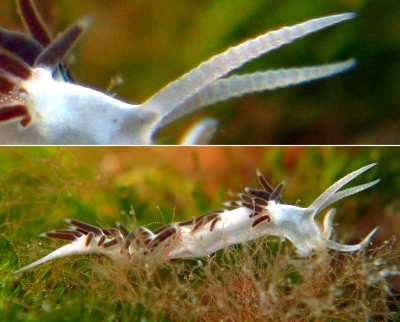
Dear Dom,
I have no experience with this species, but in general, rhinophoral ornamentation like this does develop gradually as an animal grows in size. The other thing which changes the 'look' of the ridges is the degree the rhinophore is extended or contracted. Although not exactly like an accordion, the ridges are probably much more noticeable when the rhinophores are slightly contracted. I guess the first thing to do would be to gently touch the tips of some rhinophores and see if the ridges do become more obvious. And the the other thing would be to look at a series of animals of different lengths and see if a pattern emerged.
Best wishes,
Bill Rudman
Piseinotecus gabinieri - rings on rhinophores
June 26, 2007
From: Miquel Pontes
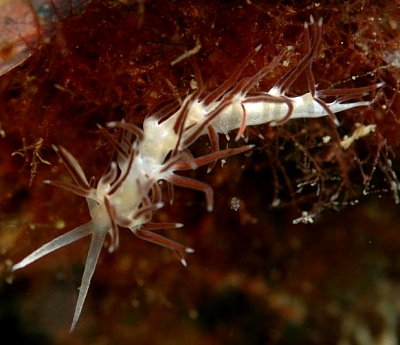

Concerning message #15263:
Hello Bill,
I have read your information regarding Piseinotecus gabinieri, a specimen we came across in our last dive. In the pictures I could take, the rhinophores are rugose (as stated in species description) but not annulated (as shown in some of the published pictures).
Could it be possible we are talking of two different species? Or perhaps this is a mere difference among specimens ?
Locality: Els Caials, Cadaqués, Costa Brava, 20 metres, Spain, Mediterranean Sea, 9 June 2007, Coralligen rock. Length: 25 mm. Photographer: Miquel Pontes.
Best regards
Miquel
http://marenostrum.org
info@marenostrum.org
Pontes, M., 2007 (Jun 26) Piseinotecus gabinieri - rings on rhinophores. [Message in] Sea Slug Forum. Australian Museum, Sydney. Available from http://www.seaslugforum.net/find/20009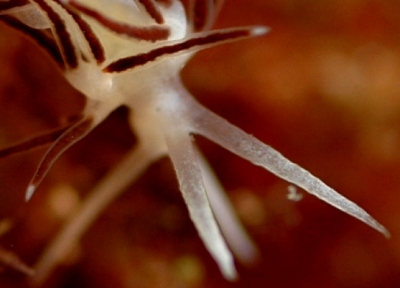
Dear Miquel,
Schmekel & Portmann (1982) describe the rhinophores as 'finely annularly wrinkled, the wrinkles discernible even when the tentacles are fully stretched'. I guess its a matter of opinion whether I can see traces of rings in the close-up of your photo alongside or not. Presuming all these animals are one species, it seems to me that there is some variation. Obviously rings are going to be more noticeable if the rhinophores are a bit contracted, but it seems that in some specimens the rings are not that obvious even when the rhinophores are contracted. Perhaps the rings are more obvious in smaller specimens? Schmekel & Portmann state that the species has a maximum length of 6 mm, yet your animal was 4 times that size. Having a quick look at the Forum photos, yours and a 30 mm long specimen from Baki Yokes [#7071] are the two biggest specimens on the Forum and they are the two in which wrinkles are least obvious.
Best wishes,
Bill Rudman
Re: Aeolid from Peru
November 16, 2005
From: Francis & Pirjo Pellet
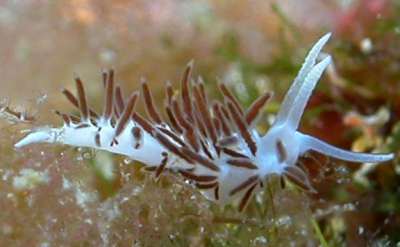
Dear Bill,
The resemblance is amazing between Katia Nakamura's aeolid from the east Pacific (north Peru) [message #15125] and this little animal seen in Mediterranean sea , La Ciotat, the 12th of Juin 2004, 12m deep, "La grotte de la vierge", about 1cm - .Piseinotecus gabinierei.
Locality: La grotte de la vierge, La Ciotat, France, Mediterranean coast. Depth: 12 m. Length: 10 mm. 12 June 2004. Photographer: Francis Pellet.
Can it be the same species ?
Best wishes
Francis & Pirjo Pellet
pirjo.pellet;@free.fr
Pellet, F.& P., 2005 (Nov 16) Re: Aeolid from Peru. [Message in] Sea Slug Forum. Australian Museum, Sydney. Available from http://www.seaslugforum.net/find/15263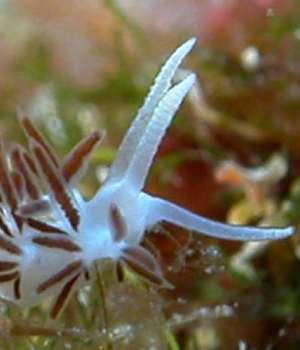
Dear Francis & Pirjo,
They certainly have similarities in colour, but it would be unlikely that the same species would be found in these two localities - although it is not completely impossible, as some species are found on both sides of the Atlantic and some Caribbean species are known from the East Pacific.
Externally, Piseinotecus has wrinkles (or slightly raised rings) on the rhinophores, while species of Cuthona are smooth, and the anterior corners of the foot are rounded in Cuthona but slightly tentacular in Piseinotecus.
Best wishes,
Bill Rudman
Piseinotecus gabinierei from France
October 11, 2003
From: Marina Poddubetskaia
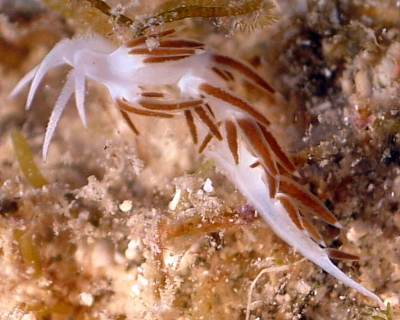
Dear Bill,
Here is a record of Piseinotecus gabinierei from France. These photos show the 'finely annularly wrinkled' nature of rhinophores well.
Both were photographed at La Ciotat on the Mediterranean coast of France.
Upper & Lower Right: October 05, 2003. Site: La calanque du Mugel. Depth: 9m. Size: 13-15mm
Lower Left: October 04, 2003. Site: Le petit Moure. Size: 6-7mm.
Photos: Marina Poddubetskaia - Nembro website
Cordially,
Marina.
nembro@nembro.info
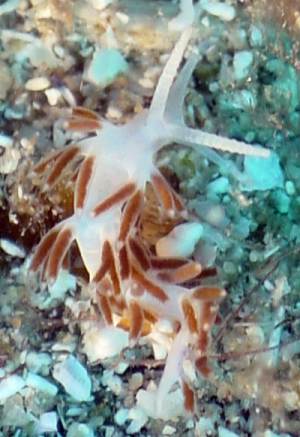
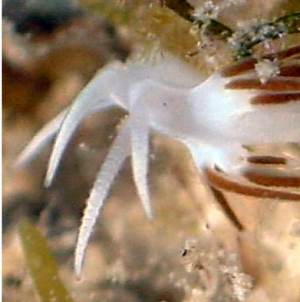
Thanks Marina,
It's nice to get a record from the western end of the Mediterranean
Best wishes
Bill Rudman
Piseinotecus gabinierei from Turkey
October 11, 2003
From: Ferda Buyukbaykal

Dear Bill,
Can you confirm this is Piseinotecus gabinierei please.
Date: September 20, 2003
Location: Ayvalik-Balikesir, Turkey
Site: Kerbela
Depth: 29 mt
Size: 15mm
Photos: Ferda Buyukbaykal
Thanks
Ferda
ferdabbaykal@isnet.net.tr
Buyukbaykal, F., 2003 (Oct 11) Piseinotecus gabinierei from Turkey. [Message in] Sea Slug Forum. Australian Museum, Sydney. Available from http://www.seaslugforum.net/find/11204Dear Ferda,
Your identification is correct
Bill Rudman
Piseinotecus gabinierei from Turkey
March 21, 2003
From: Haluk Akbatur
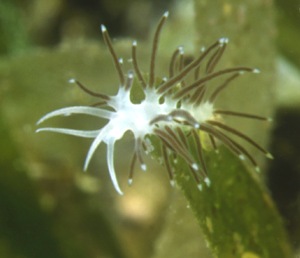
Dear Bill,
Is this Piseinotecus gabinierei? It is from the Mediterranean coast of Turkey;
Size: less than 1cm,
Depth: 30m.,
Place: Kaþ, Antalya,
Date: 2 March 2003
Thanks,
Haluk Akbatur
lasergoz@ttnet.net.tr
Akbatur, H., 2003 (Mar 21) Piseinotecus gabinierei from Turkey. [Message in] Sea Slug Forum. Australian Museum, Sydney. Available from http://www.seaslugforum.net/find/9412Dear Haluk,
Yes this is Piseinotecus gabinierei. Your photo shows the common ceratal stalk very well.
Best wishes,
Bill Rudman
Piseinotecus gabinierei? from Turkey
June 8, 2002
From: Baki Yokes
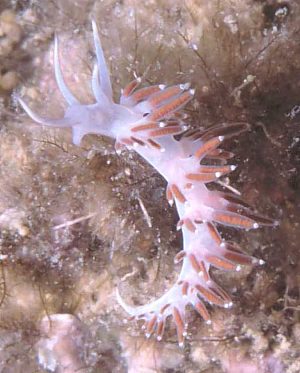
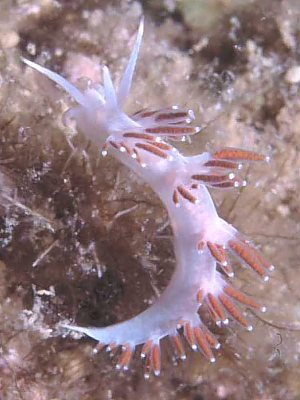
Hi Bill,
Here are two photos of a specimen pictured in Antalya, Turkey. Very smooth rhinophores and the structure of the cerata suggests Piseinotecus gabinierei. What do you think?
Date: 1 May 2002
Place: Antalya, Turkey
Divesite: Uc Adalar
Depth: 6m
Size: 3cm
Taken by: Baki Yokes
Best wishes
Baki
bakiyokes@turk.net
Yokes, B., 2002 (Jun 8) Piseinotecus gabinierei? from Turkey. [Message in] Sea Slug Forum. Australian Museum, Sydney. Available from http://www.seaslugforum.net/find/7071Thanks Baki,
I think your ID is correct. You mention smooth rhinophores. Schmekel & Portmann describe the rhinophores as being 'finely annularly wrinkled' and in your lower photo the right rhinophore does show an iregular outline.
Best wishes,
Bill Rudman
Re: Spelling of Piseinotecus gabinierei
January 22, 2001
From: Juan Lucas Cervera
Dear Bill,
The original Vicente's spelling is "gabinierei".
Cheers.
Lucas.
lucas.cervera@uca.es
Cervera. J.L., 2001 (Jan 22) Re: Spelling of Piseinotecus gabinierei. [Message in] Sea Slug Forum. Australian Museum, Sydney. Available from http://www.seaslugforum.net/find/3579Thanks Lucas,
I'll correct the spelling in the Forum
Bill Rudman
Spelling of Piseinotecus gabinierei
January 18, 2001
From: Erwin Koehler
Dear Bill,
Concerning your question about the right spelling of Piseinotecus gabinierei:
Luis Sánchez Tocino [EMAIL: lstocino@retemail.es ) wrote the name is spelled with the last "E", so it must be Piseinotecus gabinierei (Vicente, 1975)
Cheers,
Erwin
Medslugs.Koehler@t-online.de
Koehler, E., 2001 (Jan 18) Spelling of Piseinotecus gabinierei. [Message in] Sea Slug Forum. Australian Museum, Sydney. Available from http://www.seaslugforum.net/find/3548Dear Erwin,
Unfortunately it is not quite so simple. If Vicente mispelt Gabiniere's name 'Gabinier' throughout the 1975 publication then the spelling without the 'e' is the 'correct' spelling. Only if there is an error which can be seen within the publication can a spelling be changed. If I was naming a species after you and said 'I name this species Piseinotecus eriwini after Eriwin Koehler' then the name 'eriwini' is considered the correct spelling, unless there is clear evidence in the paper that your name is really spelt Erwin. If I mention your name 'Erwin Koehler' as the collector or in the acknowledgements, then this is good evidence to show your name is Erwin not Eriwin and that the correct spelling of the species name P. erwini.
In this case I unfortunately can not obtain a copy of Vicente's paper. If someone could send me one, or have a look at it I would be grateful. We need to find out how Vicente spelt the name Gabinier or Gabiniere.
• Vicente, N. (1975) Un nouveau espece de gasteropode nudibranche en Mediterrnaee Facelina gabinieri n.sp. Trav. Sci. Parc. Nat. Port. Cros., 1: 67-74
Sorry it's complicated,
Bill Rudman
Piseinotecus gabinieri from Mediterranean
September 15, 2000
From: Erwin Koehler

Dear Bill,
Here is Piseinotecus gabinieri which is spelt this way in C.L.E.M.A.M. and in the Annotated Check-List of Mediterranean Marine Mollusks by Bruno Sabelli et. al. In the Atlas of Mediterranean Nudibranchs by Cattaneo-Vietti et. al. and in Opisthobranchia des Mittelmeeres by Schmekel and Portman it is spelt Piseinotecus gabinierei. Which one is the correct spelling?
This photo was made by Franco de Lorenzi Email: cratena@libero.it in Croatia, Rab, divesite "Supetaska Draga", size 3 cm, depth 32 m, date August 16, 2000.
Erwin
Medslugs.Koehler@t-online.de
Koehler, E., 2000 (Sep 15) Piseinotecus gabinieri from Mediterranean. [Message in] Sea Slug Forum. Australian Museum, Sydney. Available from http://www.seaslugforum.net/find/3010Thanks Erwin,
I have found the title of the reference:
• Vicente, N. (1975) Un nouveau espece de gasteropode nudibranche en Mediterrnaee Facelina gabinieri n.sp. Trav. Sci. Parc. Nat. Port. Cros., 1: 67-74
This spells the name without the 'e'. Unfortunately I don't have access the text of the article. In Schmekel & Portman, who spell it Piseinotecus gabinierei, they also refer to it as Piseinotecus gabinieri in the description. Hopefully one of our Mediterranean colleagues can clarify it for us.
Best wishes,
Bill Rudman.
